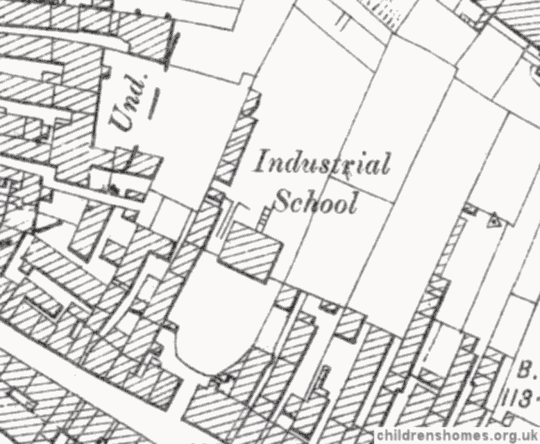Stirling Industrial School for Boys, Stirling, Stirlingshire, Scotland
In 1876, the boys from the Stirling Ragged and Industrial School on Spittal Street were transferred to their own premises a short distance away at Sauchie House, 81 Baker Street. The property, which had previously housed a bank, was formally certified to operate as an Industrial School on 29 February 1876, with accommodation for up to 50 boys. Voluntary cases could also be admitted. 76. There was a good schoolroom, good garden and exercise ground. Mr David Baerrie, formerly the schoolmaster at the Spittal Street establishment, was appointed as superintendent, with Mrs Berrie as matron.
The school site is shown on the 1898 map below.

Stirling Industrial School for Boys site, Stirling, c.1898.

Former Stirling Industrial School for Boys, Stirling, 2014. © Peter Higginbotham
An official inspection in June 1877 recorded 39 inmates under detention plus seven voluntary cases. It was suggested that the upper dormitories would be the better for a little more ventilation, and that a plunge bath should be provided. The garden was described as large and productive. All of the classroom teaching was carried out by Mr Berrie. The industrial training included tailoring, wood-chopping and gardening. A tailor came in to provide three hours' instruction each afternoon, and all the boys' clothing was made on the premises. The boys took care of the garden attached to the girls' school as well as their own. Some hair teasing was also done, an occupation much objected to by the inspector because of the dust and risk of infection it carried.
A new washhouse, bath and lavatory were constructed in 1882 at a cost of nearly £300.
In 1893, the Berries were succeeded as superintendent and matron by Mr and Mrs D. Coghill. Mr Coghill died early in 1894 and was replaced by Mr Russell, who for many years had served as schoolmaster at Paisley Industrial School. Mrs Coghill continued as matron.
In 1894, a canvas shoot was fitted in the upper part of the building for escape in case of fire. It replaced the fixed ladder which had previously been installed for the purpose, but which had been criticised by the inspector as being inadequate for a rapid and safe evacuation.
The inspection in June 1896 recorded 38 boys in the school, plus one on license. The superintendent was now Mr Andrew Smith, with Mrs Coghill still matron. The premises were described as consisting of a square house with a detached schoolroom, and a range of workshops and a laundry at the side. The schoolroom had to serve as a playroom in bad weather. The boys' playground — an uneven yard — lay between the house and the street. A small vegetable garden lay at the rear. The attics, dormitories and workshops were said to be unsatisfactory, although plans had been prepared to remedy theses defects and to provide a good swimming bath. Some drill, marching and extension motions were carried out twice a week in the summer. The boys were occasionally taken to the King's Park, and the bigger boys had been two or three times to the county cricket ground for a game. An annual day excursion was made to the seaside or countryside. Over the previous year, eight football matches and one cricket match had been played against outside teams. There was no library on no indoor games were provided. One magic lantern entertainment had been given the previous winter, and the boys had gone to a concert given by the Sabbath School teachers. Boys with friends in the neighbourhood were allowed out on Saturday afternoons. Such visits, and other privileges depended on good conduct. The development of the school was reported to be hampered by lack of funds, with its government grant forming about four-fifths of its income.
The matron, Mrs Coghill, left in November 1900 and was replaced by the Mrs Smith, the superintendent's wife. Indian club and dumb-bell exercises had now been introduced. A new playground was added to the property in 1901.
Despite many years of complaint by the inspector, all the teaching was still carried out by the superintendent. In 1902, the school was given an ultimatum that unless a competent schoolteacher was appointed, the school's management would be reported as unsatisfactory, with a resulting deduction of 1s. 6d. per pupil from its weekly grant. Accordingly, an assistant teacher, Miss Jessie Silver, took up her post on 17 June 1902 to take charge of the junior boys.
In the early 1900s, an ongoing shortage of funds, coupled with the constraints on the school's ability to expand within its confined site, made its future increasingly precarious. On 21 November 1905, it was announced that the school was to close, with its certificate formally being withdrawn six months after that date.
Records
Note: many repositories impose a closure period of up to 100 years for records identifying individuals. Before travelling a long distance, always check that the records you want to consult will be available.
- None identfied at present — any information welcome.
Census
Bibliography
- Higginbotham, Peter Children's Homes: A History of Institutional Care for Britain's Young (2017, Pen & Sword)
- Mahood, Linda Policing Gender, Class and Family: Britain, 1850-1940 (1995, Univeristy of Alberta Press)
- Prahms, Wendy Newcastle Ragged and Industrial School (2006, The History Press)
Links
- None noted at present.
Except where indicated, this page () © Peter Higginbotham. Contents may not be reproduced without permission.


